Cosmological Parameter Inference with Bayesian Statistics
Abstract
:1. Introduction
2. Bayesian vs. Frequentist Statistics
2.1. Frequentist Statistics
2.2. Bayesian Statistics
2.3. Comparing Both Descriptions
- Frequentist approach. As mentioned previously, in Frequentist statistics probability is related to the frequency of events, then our best estimate for p is . So, the probability of having 2 heads in a row is .
- Bayesian approach. In Bayesian statistics, p is not a value; it is a random variable with its own distribution, and it must be defined by the existing evidence (the 14 trials and 10 successes). Then, by considering that we do not know anything about p a priori and averaging over all possible values of p, we have that the probability of having two heads isThis Bayesian example will be expanded in detail during the following section, but, for now, we just want to stress out that both approximations arrive at different results.
3. A First Look at Bayesian Statistics
3.1. Bayes’ Theorem, Priors, Posteriors, and All That Stuff
3.2. Updating the Probability Distribution
3.3. About the Likelihood
3.4. Letting Aside the Priors
3.5. Chi-Square and Goodness of Fit
- The model is wrong and can be rejected.
- The errors are underestimated.
- The error measurements are not normally distributed.
- Errors have been overestimated.
- Data are correlated or non-independent.
- The distribution is non-Gaussian.
3.6. Contour Plots and Confidence Regions
- 1.
- Let M be the number of parameters, n the number of data and p the confidence limit desired.
- 2.
- Solve the equation:
- 3.
- Find the parameter region where . This defines the confidence region.
3.7. Marginalization
3.8. Fisher Matrix
Constructing Fisher Matrices: A Simple Description
3.9. Importance Sampling
3.10. Combining Datasets: Hyperparameter Method
4. Numerical Tools
4.1. MCMC Techniques for Parameter Inference
4.1.1. Metropolis-Hastings Algorithm
- 1.
- Choose a random initial condition in the parameter space and compute the posterior distribution.
- 2.
- Generate a new candidate from a proposal distribution in the parameter space and compute the corresponding posterior distribution.
- 3.
- Accept (or reject) the new point with the help of the Metropolis-Hastings algorithm.
- 4.
- If the point is rejected, repeat the previous point in the chain.
- 5.
- Repeat steps 2–4 until you have a large enough chain.
4.1.2. A First Example of Parameter Inference
4.1.3. Convergence Test
4.1.4. Some Useful Details
More Samplers
- 1.
- consists of k blocks . Then, at step i
- 2.
- Draw from
- 3.
- Draw from
- 4.
- …
- 5.
- Draw from
- 6.
- Repeat the above steps for the wished iterations with .
5. Fitting a Straight-Line
- 1.
- Consider two datasets coming from the same straight-line but having different errors.
- 2.
- Consider two datasets coming from different straight-lines and also having different errors.
5.1. Case 1
5.2. Case 2
6. Bayesian Statistics in Cosmology
6.1. Theoretical Background
6.1.1. Einstein Field Equations
6.1.2. Friedmann and Continuity Equations
6.1.3. Content of the Universe
- Dust: It has no pressure, and its energy density takes the form of Dust is conformed by baryons (ordinary matter).
- Dark matter: It is proposed to explain several astrophysical observations, like the dynamics of galaxies in the Coma cluster or the rotation curves of galaxies [49,50]. The CDM model assumes the dark matter only interacts gravitationally (and possibly by weak interaction) with the rest of the Universe, hence its name, Cold Dark Matter (CDM). Since it is proposed as interacting only via gravitational force, there can be several candidates to fulfill this requirement: it could be conformed by weakly interacting massive particles (WIMPs), by gravitationally-interacting massive particles (GIMPs); by axions (hypothetical elementary particles); or by sterile neutrinos, just to mention a few. For a short review about Dark Matter and possible candidates, see Reference [51].
- Radiation: This corresponds to relativistic particles that follow the relation , which implies a density with a behavior . We consider photons and massless neutrinos as radiation, so the total radiation energy density in the Universe is given byThe relation between these quantities iswhere is the effective number of relativistic degrees of freedom, with standard value [13].
- Dark Energy: It is introduced to explain the current accelerated expansion of the Universe. In the CDM model, dark energy is given by the cosmological constant or equivalently by an equation-of-state .
6.1.4. Alternatives to the CDM Model
6.2. Cosmological Parameters
6.2.1. Base Parameters
6.2.2. Derived Parameters
6.3. Cosmological Observations
7. Parameters Inference in Cosmology
7.1. Cosmological and Statistical Codes
7.1.1. Cosmological Codes
7.1.2. Statistical Codes
8. Examples with SimpleMC
Models of the Universe
9. Conclusions and Discussion
Author Contributions
Funding
Acknowledgments
Conflicts of Interest
| 1 | These rules are defined for a continuous variable; however, the corresponding discrete definition can be given immediately by replacing . |
References
- Trimble, V. The 1920 shapley-curtis discussion: Background, issues, and aftermath. Publ. Astron. Soc. Pac. 1995, 107, 1133. [Google Scholar] [CrossRef] [Green Version]
- Turner, M.S. David Norman Schramm, a Biographical Memoir. Available online: http://www.nasonline.org/publications/biographical-memoirs/memoir-pdfs/schramm-david.pdf (accessed on 18 May 2021).
- Kleijn, B. Bayesian Statistics; University of Amsterdam Lecture Notes: Amsterdam, The Netherlands, 2013. [Google Scholar]
- Heavens, A. Statistical techniques in cosmology. arXiv 2009, arXiv:0906.0664. [Google Scholar]
- Trotta, R. Bayes in the sky: Bayesian inference and model selection in cosmology. Contemp. Phys. 2008, 49, 71. [Google Scholar] [CrossRef] [Green Version]
- Verde, L. Statistical methods in cosmology. In Lectures on Cosmology; Springer: Berlin/Heidelberg, Germany, 2010; Volume 800, pp. 147–177. [Google Scholar]
- Trotta, R. Bayesian Methods in Cosmology. arXiv 2017, arXiv:1701.01467. [Google Scholar]
- Jaffe, A.H. H0 and odds on cosmology. Astrophys. J. 1996, 24, 471. [Google Scholar] [CrossRef] [Green Version]
- WMAP Collaboration. First year Wilkinson Microwave Anisotropy Probe (WMAP) observations: Parameter estimation methodology. Astrophys. J. Suppl. 2003, 148, 195. [Google Scholar] [CrossRef]
- D’Agostini, G. Probability and measurement uncertainty in physics: A Bayesian primer. arXiv 1995, arXiv:hep-ph/9512295. [Google Scholar]
- Sharma, S. Markov Chain Monte Carlo Methods for Bayesian Data Analysis in Astronomy. Annu. Rev. Astron. Astrophys. 2017, 55, 213–259. [Google Scholar]
- Liddle, A.R. How many cosmological parameters? Mon. Not. Roy. Astron. Soc. 2004, 351, L49. [Google Scholar] [CrossRef] [Green Version]
- Lahav, O.; Liddle, A.R. The Cosmological Parameters 2014. arxiv 2010, arXiv:1401.1389. [Google Scholar]
- Mohammad-Djafari, A. Bayesian inference for inverse problems. Bayesian Inference and Maximum Entropy Methods in Science and Engineering. AIP Conf. Proc. Am. Inst. Phys. 2002, 617, 477–496. [Google Scholar]
- Vazquez, J.A.; Lasenby, A.N.; Bridges, M.; Hobson, M.P. A Bayesian study of the primordial power spectrum from a novel closed universe model. Mon. Not. Roy. Astron. Soc. 2012, 422, 1948. [Google Scholar] [CrossRef] [Green Version]
- Press, W.H.; Teukolsky, S.A.; Vetterling, W.T.; Flannery, B.P. Numerical Recipes 3rd Edition: The Art of Scientific Computing; Cambridge University Press: Cambridge, UK, 2007. [Google Scholar]
- Fisher, R.A. The logic of inductive inference. J. R. Stat. Soc. 1935, 98, 39. [Google Scholar] [CrossRef] [Green Version]
- Albrecht, A.; Bernstein, G.; Cahn, R.; Freedman, W.L.; Hewitt, J.; Hu, W.; Huth, J.; Kamionkowski, M.; Kolb, E.W.; Knox, L.; et al. Report of the Dark Energy Task Force. arXiv 2006, arXiv:astro-ph/0609591. [Google Scholar]
- Tokdar, S.T.; Kass, R.E. Importance sampling: A Review. Wiley Interdiscip. Rev. Comput. Stat. 2010, 2, 54. [Google Scholar] [CrossRef]
- Lahav, O.; Bridle, S.L.; Hobson, M.P.; Lasenby, A.N.; Sodre, L., Jr. Bayesian ‘hyper-parameters’ approach to joint estimation: The hubble constant from cmb measurements. Mon. Not. Roy. Astron. Soc. 2000, 315, L45. [Google Scholar] [CrossRef] [Green Version]
- Hobson, M.P.; Bridle, S.L.; Lahav, O. Combining cosmological datasets: Hyperparameters and bayesian evidence. Mon. Not. Roy. Astron. Soc. 2002, 335, 377. [Google Scholar] [CrossRef]
- Medel, R.; Gomez, I.; Vazquez, J.A.; Garcia, R. An introduction to markov chain monte carlo. Bol. Estad. Investig. Oper. 2021, 37, 47. [Google Scholar]
- Tanner, M.A. Tools for Statistical Inference; Springer: Berlin/Heidelberg, Germany, 2012. [Google Scholar]
- Gilks, W.R.; Richardson, S.; Spiegelhalter, D. Markov Chain Monte Carlo in Practice; Chapman and Hall/CRC: New York, NY, USA, 1995. [Google Scholar]
- Gelman, A.; Carlin, J.B.; Stern, H.S.; Dunson, D.B.; Vehtari, A.; Rubin, D.B. Bayesian Data Analysis; Chapman and Hall/CRC: New York, NY, USA, 2013. [Google Scholar]
- Ross, S.M. Introduction to Probability Models; Academic Press: Cambridge, MA, USA, 2014. [Google Scholar]
- Metropolis, N.; Rosenbluth, A.W.; Rosenbluth, M.N.; Teller, A.H.; Teller, E. Equation of state calculations by fast computing machines. J. Chem. Phys. 1953, 21, 1087. [Google Scholar] [CrossRef] [Green Version]
- Hastings, W.K. Monte Carlo Sampling Methods Using Markov Chains and Their Applications. Biometrika 1970, 57, 97. [Google Scholar] [CrossRef]
- Salvatier, J.; Wiecki, T.V.; Fonnesbeck, C. Probabilistic programming in python using pymc3. PeerJ Comput. Sci. 2016, 2, e55. [Google Scholar] [CrossRef] [Green Version]
- Gelman, A.; Rubin, D.B. Inference from iterative simulation using multiple sequences. Stat. Sci. 1992, 7, 457. [Google Scholar] [CrossRef]
- Brooks, S.P.; Gelman, A. General methods for monitoring convergence of iterative simulations. J. Comput. Graph. Stat. 1998, 7, 434. [Google Scholar]
- Link, W.; Eaton, M. On thinning of chains in mcmc. methods in ecology and evolution. Methods Ecol. Evol. 2012, 3, 112–115. [Google Scholar] [CrossRef]
- Geweke, J. Evaluating the Accuracy of Sampling-Based Approaches to the Calculation of Posterior Moments; Federal Reserve Bank of Minneapolis, Research Department Minneapolis: Minneapolis, MN, USA, 1991; Volume 196. [Google Scholar]
- Model Checking and Diagnostics. 2021. Available online: https://pymc-devs.github.io/pymc/modelchecking.html (accessed on 18 May 2021).
- Geman, S.; Geman, D. Stochastic relaxation, gibbs distributions, and the bayesian restoration of images. IEEE Trans. Pattern Anal. Mach. Intell. 1984, 721–741. [Google Scholar] [CrossRef] [PubMed]
- Vousden, W.; Farr, W.M.; Mandel, I. Dynamic temperature selection for parallel tempering in markov chain monte carlo simulations. Mon. Not. R. Astron. Soc. 2015, 455, 1919. [Google Scholar] [CrossRef]
- Cappé, O.; Guillin, A.; Marin, J.M.; Robert, C.P. Population Monte Carlo. J. Comput. Graph. Stat. 2004, 13, 907. [Google Scholar] [CrossRef]
- Kilbinger, M.; Benabed, K.; Cappe, O.; Cardoso, J.-F.; Coupon, J.; Fort, G.; McCracken, H.J.; Prunet, S.; Robert, C.P.; Wraith, D. CosmoPMC: Cosmology Population Monte Carlo. arXiv 2012, arXiv:1101.0950. [Google Scholar]
- Foreman-Mackey, D.; Hogg, D.W.; Lang, D.; Goodman, J. emcee: The MCMC Hammer. Publ. Astron. Soc. Pac. 2013, 125, 306. [Google Scholar] [CrossRef] [Green Version]
- emcee. 2021. Available online: http://dfm.io/emcee/current/ (accessed on 18 May 2021).
- Goodman, J.; Weare, J. Ensemble samplers with affine invariance. Commun. Appl. Math. Comput. Sci. 2010, 5, 65. [Google Scholar] [CrossRef]
- Hanson, K.M. Markov chain monte carlo posterior sampling with the hamiltonian method. In Proceedings of the Medical Imaging 2001: Image Processing. International Society for Optics and Photonics, Los Alamos, NM, USA, 21 February 2001; Volume 4322, pp. 456–467. [Google Scholar]
- Neal, R.M. Mcmc using hamiltonian dynamics. Handb. Markov Chain. Monte Carlo 2011, 2, 2. [Google Scholar]
- Available online: https://github.com/ja-vazquez/Cosmologia_observacional.git (accessed on 18 May 2021).
- Baumann, D. Cosmology, Part III Mathematical Tripos; University Lecture Notes: Cambridge, UK, 2014. [Google Scholar]
- Wald, R. General relativity. the university of chicago. Chicago Sect. 1984, 6, 72–73. [Google Scholar]
- Iorio, L. Editorial for the Special Issue 100 Years of Chronogeometrodynamics: The Status of the Einstein’s Theory of Gravitation in Its Centennial Year. Universe 2015, 1, 38. [Google Scholar] [CrossRef] [Green Version]
- Debono, I.; Smoot, G.F. General Relativity and Cosmology: Unsolved Questions and Future Directions. Universe 2016, 2, 23. [Google Scholar] [CrossRef]
- Liddle, A. An Introduction to Modern Cosmology; John Wiley & Sons: Hoboken, NJ, USA, 2015. [Google Scholar]
- Vázquez-González, A.; Matos, T. La materia oscura del universo: Retos y perspectivas. Rev. Mex. FíSica 2008, 54, 193. [Google Scholar]
- Arun, K.; Gudennavar, S.; Sivaram, C. Dark matter, dark energy, and alternate models: A review. Adv. Space Res. 2017, 60, 166. [Google Scholar] [CrossRef] [Green Version]
- Bull, P.; Akrami, Y.; Adamek, J.; Baker, T.; Bellini, E.; Jiménez, J.B.; Bentivegna, E.; Camera, S.; Clesse, S.; Davis, J.H.; et al. Beyond ΛCDM: Problems, solutions, and the road ahead. Phys. Dark Univ. 2016, 12, 56. [Google Scholar] [CrossRef] [Green Version]
- Matos, T.; Luevano, J.-R.; Quiros, I.; Urena-Lopez, L.A.; Vazquez, J.A. Dynamics of Scalar Field Dark Matter With a Cosh-like Potential. Phys. Rev. D 2009, 80, 123521. [Google Scholar] [CrossRef] [Green Version]
- Sin, S.-J. Late-time phase transition and the galactic halo as a bose liquid. Phys. Rev. 1994, 50, 3650. [Google Scholar] [CrossRef] [Green Version]
- FGuzman, S.; Matos, T.; Villegas, H. Scalar fields as dark matter in spiral galaxies: Comparison with experiments. Astron. Nachrichten News Astron. Astrophys. 1999, 320, 97. [Google Scholar] [CrossRef]
- Matos, T.; Guzman, F.S. Scalar fields as dark matter in spiral galaxies. Class. Quant. Grav. 2000, 17, L9. [Google Scholar] [CrossRef]
- Lee, J.-W.; Koh, I.-G. Galactic halos as boson stars. Phys. Rev. D 1996, 53, 2236. [Google Scholar] [CrossRef] [PubMed] [Green Version]
- Matos, T.; Vazquez-Gonzalez, A.; Magana, J. ϕ2 as Dark Matter. Mon. Not. Roy. Astron. Soc. 2009, 393, 1359. [Google Scholar] [CrossRef] [Green Version]
- Spergel, D.N.; Steinhardt, P.J. Observational evidence for selfinteracting cold dark matter. Phys. Rev. Lett. 2000, 84, 3760. [Google Scholar] [CrossRef] [PubMed] [Green Version]
- Gonzalez, T.; Matos, T.; Quiros, I.; Vazquez-Gonzalez, A. Self-interacting Scalar Field Trapped in a Randall-Sundrum Braneworld: The Dynamical Systems Perspective. Phys. Lett. B 2009, 676, 161. [Google Scholar] [CrossRef] [Green Version]
- Padilla, L.E.; Vázquez, J.A.; Matos, T.; Germán, G. Scalar Field Dark Matter Spectator During Inflation: The Effect of Self-interaction. JCAP 2019, 5, 56. [Google Scholar] [CrossRef] [Green Version]
- Felice, A.D.; Tsujikawa, S. f(R) theories. Living Rev. Rel. 2010, 13, 3. [Google Scholar] [CrossRef] [Green Version]
- Nojiri, S.; Odintsov, S.; Oikonomou, V. Modified gravity theories on a nutshell: Inflation, bounce and late-time evolution. Phys. Rep. 2017, 692, 1. [Google Scholar] [CrossRef] [Green Version]
- Garcia-Aspeitia, M.A.; Hernandez-Almada, A.; Na, J.M.; Amante, M.H.; Motta, V.; Martínez-Robles, C. Brane with variable tension as a possible solution to the problem of the late cosmic acceleration. Phys. Rev. D 2018, 97. [Google Scholar] [CrossRef] [Green Version]
- Vázquez, J.A.; Tamayo, D.; Sen, A.A.; Quiros, I. Bayesian model selection on scalar ϵ-field dark energy. Phys. Rev. D 2021, 103. [Google Scholar] [CrossRef]
- Akarsu, O.; Katirci, N.; Sen, A.A.; Vazquez, J.A. Scalar field emulator via anisotropically deformed vacuum energy: Application to dark energy. arXiv 2020, arXiv:2004.14863. [Google Scholar]
- Tsujikawa, S. Quintessence: A Review. Class. Quant. Grav. 2013, 30. [Google Scholar] [CrossRef] [Green Version]
- Yoo, J.; Watanabe, Y. Theoretical Models of Dark Energy. Int. J. Mod. Phys. D 2012, 21. [Google Scholar] [CrossRef] [Green Version]
- Feng, B. The quintom model of dark energy. arXiv 2006, arXiv:astro-ph/0602156. [Google Scholar]
- Akarsu, O.; Katırcı, N.; Özdemir, N.; Vázquez, J.A. Anisotropic massive Brans-Dicke gravity extension of the standard ΛCDM model. Eur. Phys. J. C 2020, 80. [Google Scholar] [CrossRef] [Green Version]
- Sharif, M.; Azeem, S. Dark energy models and cosmic acceleration with anisotropic universe in f (t) gravity. Commun. Theor. Phys. 2014, 61, 482. [Google Scholar] [CrossRef]
- Saadeh, D.; Feeney, S.M.; Pontzen, A.; Peiris, H.V.; McEwen, J.D. How isotropic is the universe? Phys. Rev. Lett. 2016, 117, 131302. [Google Scholar] [CrossRef]
- Linden, S.; Virey, J.-M. A test of the CPL parameterization for rapid dark energy equation of state transitions. Phys. Rev. D 2008, 78, 023526. [Google Scholar] [CrossRef] [Green Version]
- Scherrer, R.J. Mapping the Chevallier-Polarski-Linder parametrization onto Physical Dark Energy Models. Phys. Rev. D 2015, 92, 043001. [Google Scholar] [CrossRef] [Green Version]
- Tamayo, D.; Vazquez, J.A. Fourier-series expansion of the dark-energy equation of state. Mon. Not. Roy. Astron. Soc. 2019, 487. [Google Scholar] [CrossRef] [Green Version]
- Vazquez, J.A.; Bridges, M.; Hobson, M.P.; Lasenby, A.N. Reconstruction of the Dark Energy equation of state. JCAP 2012, 9. [Google Scholar] [CrossRef] [Green Version]
- Hee, S.; Vázquez, J.A.; Handley, W.J.; Hobson, M.P.; Lasenby, A.N. Constraining the dark energy equation of state using Bayes theorem and the Kullback–Leibler divergence. Mon. Not. Roy. Astron. Soc. 2017, 466, 369. [Google Scholar] [CrossRef]
- Vazquez, J.A.; Hee, S.; Hobson, M.P.; Lasenby, A.N.; Ibison, M.; Bridges, M. Observational constraints on conformal time symmetry, missing matter and double dark energy. JCAP 2018, 7, 62. [Google Scholar] [CrossRef] [Green Version]
- Aubourg, E.; Bailey, S.; Bautista, J.E.; Beutler, F.; Bhardwaj, V.; Bizyaev, D.; Blanton, M.; Blomqvist, M.; Bolton, A.S.; Bovy, J.; et al. Cosmological implications of baryon acoustic oscillation measurements. Phys. Rev. D 2015, 92, 123516. [Google Scholar] [CrossRef] [Green Version]
- Beutler, F.; Blake, C.; Colless, M.; Jones, D.H.; Staveley-Smith, L.; Campbell, L.; Parker, Q.; Saunders, W.; Watson, F. The 6dF Galaxy Survey: Baryon Acoustic Oscillations and the Local Hubble Constant. Mon. Not. Roy. Astron. Soc. 2011, 416, 3017. [Google Scholar] [CrossRef]
- SDSS Collaboration. Spectroscopic target selection for the Sloan Digital Sky Survey: The Luminous red galaxy sample. Astron. J. 2001, 122, 2267. [Google Scholar] [CrossRef]
- Anderson, L.; Aubourg, E.; Bailey, S.; Beutler, F.; Bhardwaj, V.; Blanton, M.; Bolton, A.S.; Brinkmann, J.; Brownstein, J.R.; Burden, A.; et al. The clustering of galaxies in the SDSS-III Baryon Oscillation Spectroscopic Survey: Baryon Acoustic Oscillations in the Data Release 9 Spectroscopic Galaxy Sample. Mon. Not. Roy. Astron. Soc. 2013, 427, 3435. [Google Scholar] [CrossRef] [Green Version]
- Busca, N.G.; Delubac, T.; Rich, J.; Bailey, S.; Font-Ribera, A.; Kirkby, D.; Le Goff, J.-M.; Pieri, M.M.; Slosar, A.; Aubourg, E.; et al. Baryon Acoustic Oscillations in the Ly-α forest of BOSS quasars. Astron. Astrophys. 2013, 552, A96. [Google Scholar] [CrossRef] [Green Version]
- BOSS Collaboration. Quasar-Lyman α Forest Cross-Correlation from BOSS DR11: Baryon Acoustic Oscillations. JCAP 2014, 5, 27. [Google Scholar]
- Planck Collaboration. Planck 2013 results. XVI. Cosmological parameters. Astron. Astrophys. 2014, 571, A16. [Google Scholar] [CrossRef] [Green Version]
- What Is a Supernova. 2021. Available online: https://www.nasa.gov/audience/forstudents/5-8/features/nasa-knows/what-is-a-supernova.html (accessed on 18 May 2021).
- Riess, A.G.; Filippenko, A.V.; Challis, P.; Clocchiatti, A.; Diercks, A.; Garnavich, P.M.; Gilliland, R.L.; Hogan, C.J.; Jha, S.; Kirshner, R.P.; et al. Observational evidence from supernovae for an accelerating universe and a cosmological constant. Astron. J. 1998, 116, 1009. [Google Scholar] [CrossRef] [Green Version]
- Supernova Search Team Collaboration. Supernova limits on the cosmic equation of state. Astrophys. J. 1998, 509, 74. [Google Scholar] [CrossRef] [Green Version]
- Supernova Cosmology Project Collaboration. Measurements of Ω and Λ from 42 high redshift supernovae. Astrophys. J. 1999, 517, 565. [Google Scholar] [CrossRef]
- SDSS Collaboration. Improved cosmological constraints from a joint analysis of the SDSS-II and SNLS supernova samples. Astron. Astrophys. 2014, 568, A22. [Google Scholar] [CrossRef]
- SNLS Collaboration. SNLS—The Supernova Legacy Survey. ASP Conf. Ser. 2005, 339, 60. [Google Scholar]
- Vishwakarma, R.G.; Narlikar, J.V. Is it no Longer Necessary to Test Cosmologies with Type Ia Supernovae? Universe 2018, 4, 73. [Google Scholar] [CrossRef] [Green Version]
- SDSS-II/SNLS3 Joint Light-Curve Analysis. 2021. Available online: http://supernovae.in2p3.fr/sdss_snls_jla/ReadMe.html#sec-4-1 (accessed on 18 May 2021).
- Mather, J.C.; Cheng, E.S.; Eplee, R.E., Jr.; Isaacman, R.B.; Meyer, S.S.; Shafer, R.A.; Weiss, R.; Wright, E.L.; Bennett, C.L.; Boggess, N.W.; et al. A Preliminary measurement of the Cosmic Microwave Background spectrum by the Cosmic Background Explorer (COBE) satellite. Astrophys. J. Lett. 1990, 354, L37. [Google Scholar] [CrossRef]
- Bennett, C.L.; Hill, R.S.; Hinshaw, G.; Larson, D.; Smith, K.M.; Dunkley, J.; Gold, B.; Halpern, M.; Jarosik, N.; Kogut, A.; et al. Seven-Year Wilkinson Microwave Anisotropy Probe (WMAP) Observations: Are There Cosmic Microwave Background Anomalies? Astrophys. J. Suppl. 2011, 192, 17. [Google Scholar] [CrossRef] [Green Version]
- Planck Collaboration. Planck 2018 results. VI. Cosmological parameters. Astron. Astrophys. 2020, 641, A6. [Google Scholar] [CrossRef] [Green Version]
- Planck Collaboration. Planck 2018 results. VII. Isotropy and Statistics of the CMB. Astron. Astrophys. 2020, 641, A7. [Google Scholar] [CrossRef] [Green Version]
- Planck Collaboration. Planck 2018 results. X. Constraints on inflation. Astron. Astrophys. 2020, 641, A10. [Google Scholar] [CrossRef] [Green Version]
- Staggs, S.; Dunkley, J.; Page, L. Recent discoveries from the cosmic microwave background: A review of recent progress. Rep. Prog. Phys. 2018, 81, 044901. [Google Scholar] [CrossRef] [PubMed] [Green Version]
- Samtleben, D.; Staggs, S.; Winstein, B. The cosmic microwave background for pedestrians: A review for particle and nuclear physicists. Annu. Rev. Nucl. Part. Sci. 2007, 57, 245. [Google Scholar] [CrossRef]
- Kamionkowski, M.; Kosowsky, A. The cosmic microwave background and particle physics . Annu. Rev. Nucl. Part. Sci. 1999, 49, 77. [Google Scholar] [CrossRef] [Green Version]
- Erickcek, A.L.; Carroll, S.M.; Kamionkowski, M. Superhorizon perturbations and the cosmic microwave background. Phys. Rev. D 2008, 78, 083012. [Google Scholar] [CrossRef] [Green Version]
- Kamionkowski, M.; Kosowsky, A.; Stebbins, A. Statistics of cosmic microwave background polarization. Phys. Rev. D 1997, 55, 7368. [Google Scholar] [CrossRef] [Green Version]
- Stern, D.; Jimenez, R.; Verde, L.; Stanford, S.A.; Kamionkowski, M. Cosmic Chronometers: Constraining the Equation of State of Dark Energy. II. A Spectroscopic Catalog of Red Galaxies in Galaxy Clusters. Astrophys. J. Suppl. 2010, 188, 280. [Google Scholar] [CrossRef]
- Stern, D.; Jimenez, R.; Verde, L.; Kamionkowski, M.; Stanford, S.A. Cosmic Chronometers: Constraining the Equation of State of Dark Energy. I: H(z) Measurements. JCAP 2010, 2, 008. [Google Scholar] [CrossRef] [Green Version]
- Moresco, M.; Cimatti, A.; Jimenez, R.; Pozzetti, L.; Zamorani, G.; Bolzonella, M.; Dunlop, J.; Lamareille, F.; Mignoli, M.; Pearce, H.; et al. Improved constraints on the expansion rate of the Universe up to z~1.1 from the spectroscopic evolution of cosmic chronometers. JCAP 2012, 8, 6. [Google Scholar] [CrossRef] [Green Version]
- Moresco, M.; Verde, L.; Pozzetti, L.; Jimenez, R.; Cimatti, A. New constraints on cosmological parameters and neutrino properties using the expansion rate of the Universe to z~1.75. JCAP 2012, 7, 053. [Google Scholar] [CrossRef] [Green Version]
- Moresco, M. Raising the bar: New constraints on the hubble parameter with cosmic chronometers at z 2. Mon. Not. R. Astron. Soc. Lett. 2015, 450, L16. [Google Scholar] [CrossRef] [Green Version]
- Moresco, M.; Pozzetti, L.; Cimatti, A.; Jimenez, R.; Maraston, C.; Verde, L.; Thomas, D.; Citro, A.; Tojeiro, R.; Wilkinson, D. A 6% measurement of the Hubble parameter at z∼0.45: Direct evidence of the epoch of cosmic re-acceleration. JCAP 2016, 5, 14. [Google Scholar] [CrossRef] [Green Version]
- LIGO Scientific, Virgo, 1M2H, Dark Energy Camera GW-E, DES, DLT40, Las Cumbres Observatory, VINROUGE, MASTER Collaboration. A gravitational-wave standard siren measurement of the Hubble constant. Nature 2017, 551, 85. [Google Scholar] [CrossRef] [Green Version]
- Guidorzi, C.; Margutti, R.; Brout, D.; Scolnic, D.; Fong, W.; Alexander, K.D.; Cowperthwaite, P.S.; Annis, J.; Berger, E.; Blanchard, P.K.; et al. Improved Constraints on H0 from a Combined Analysis of Gravitational-wave and Electromagnetic Emission from GW170817. Astrophys. J. Lett. 2017, 851, L36. [Google Scholar] [CrossRef] [Green Version]
- Mandelbaum, R. Weak lensing for precision cosmology. Annu. Rev. Astron. Astrophys. 2018, 56, 393. [Google Scholar] [CrossRef] [Green Version]
- Hoekstra, H.; Jain, B. Weak gravitational lensing and its cosmological applications. Annu. Rev. Nucl. Part. Sci. 2008, 58, 99. [Google Scholar] [CrossRef] [Green Version]
- Blandford, R.; Narayan, R. Cosmological applications of gravitational lensing. Annu. Rev. Astron. Astrophys. 1992, 30, 311. [Google Scholar] [CrossRef]
- Smith, K.M.; Zahn, O.; Dore, O. Detection of gravitational lensing in the cosmic microwave background. Phys. Rev. D 2007, 76, 043510. [Google Scholar] [CrossRef] [Green Version]
- Refregier, A. Weak gravitational lensing by large-scale structure. Annu. Rev. Astron. Astrophys. 2003, 41, 645. [Google Scholar] [CrossRef] [Green Version]
- Sehgal, N.; Trac, H.; Acquaviva, V.; Ade, P.A.; Aguirre, P.; Amiri, M.; Appel, J.W.; Barrientos, L.F.; Battistelli, E.S.; Bond, J.R.; et al. The atacama cosmology telescope: Cosmology from galaxy clusters detected via the sunyaev-zel’dovich effect. Astrophys. J. 2011, 732, 44. [Google Scholar] [CrossRef]
- Allen, S.W.; Evrard, A.E.; Mantz, A.B. Cosmological parameters from observations of galaxy clusters . Annu. Rev. Astron. Astrophys. 2011, 49, 409. [Google Scholar] [CrossRef] [Green Version]
- Hasselfield, M.; Hilton, M.; Marriage, T.A.; Addison, G.E.; Barrientos, L.F.; Battaglia, N.; Battistelli, E.S.; Bond, J.R.; Crichton, D.; Das, S.; et al. The atacama cosmology telescope: Sunyaev-zel’dovich selected galaxy clusters at 148 ghz from three seasons of data. J. Cosmol. Astropart. Phys. 2013, 2013, 008. [Google Scholar] [CrossRef] [Green Version]
- Borgani, S.; Murante, G.; Springel, V.; Diaferio, A.; Dolag, K.; Moscardini, L.; Tormen, G.; Tornatore, L.; Tozzi, P. X-ray properties of galaxy clusters and groups from a cosmological hydrodynamical simulation. Mon. Not. R. Astron. Soc. 2004, 348, 1078. [Google Scholar] [CrossRef] [Green Version]
- Schneider, A.; Teyssier, R.; Potter, D.; Stadel, J.; Onions, J.; Reed, D.S.; Smith, R.E.; Springel, V.; Pearce, F.R.; Scoccimarro, R. Matter power spectrum and the challenge of percent accuracy. J. Cosmol. Astropart. Phys. 2016, 2016, 47. [Google Scholar] [CrossRef] [Green Version]
- Habib, S.; Heitmann, K.; Higdon, D.; Nakhleh, C.; Williams, B. Cosmic calibration: Constraints from the matter power spectrum and the cosmic microwave background. Phys. Rev. D 2007, 76, 083503. [Google Scholar] [CrossRef] [Green Version]
- Rudd, J.; Whelan, K. Modeling inflation dynamics: A critical review of recent research. J. Money Credit. Bank. 2007, 39, 155. [Google Scholar] [CrossRef]
- Agulló, I.; Navarro-Salas, J.; Olmo, G.J.; Parker, L. Revising the observable consequences of slow-roll inflation. Phys. Rev. D 2010, 81, 043514. [Google Scholar] [CrossRef] [Green Version]
- Vázquez, J.A.; Padilla, L.E.; Matos, T. Inflationary Cosmology: From Theory to Observations. arXiv 2018, arXiv:1810.09934. [Google Scholar]
- Seljak, U.; Zaldarriaga, M. A Line of sight integration approach to cosmic microwave background anisotropies. Astrophys. J. 1996, 469, 437. [Google Scholar] [CrossRef] [Green Version]
- Zaldarriaga, M.; Seljak, U.; Bertschinger, E. Integral solution for the microwave background anisotropies in nonflat universes. Astrophys. J. 1998, 494, 491. [Google Scholar] [CrossRef] [Green Version]
- Zaldarriaga, M.; Seljak, U. Cmbfast for spatially closed universes. Astrophys. J. Suppl. 2000, 129, 431. [Google Scholar] [CrossRef] [Green Version]
- Doran, M. CMBEASY: An object oriented code for the cosmic microwave background. JCAP 2005, 10, 11. [Google Scholar] [CrossRef]
- Lewis, A.; Challinor, A.; Lasenby, A. Efficient computation of CMB anisotropies in closed FRW models. Astrophys. J. 2000, 538, 473. [Google Scholar] [CrossRef] [Green Version]
- Howlett, C.; Lewis, A.; Hall, A.; Challinor, A. CMB power spectrum parameter degeneracies in the era of precision cosmology. JCAP 2012, 1204, 27. [Google Scholar] [CrossRef]
- Blas, D.; Lesgourgues, J.; Tram, T. The Cosmic Linear Anisotropy Solving System (CLASS) II: Approximation schemes. JCAP 2011, 7, 34. [Google Scholar] [CrossRef] [Green Version]
- Zumalacárregui, M.; Bellini, E.; Sawicki, I.; Lesgourgues, J.; Ferreira, P.G. hi_class: Horndeski in the Cosmic Linear Anisotropy Solving System. JCAP 2017, 8, 19. [Google Scholar] [CrossRef] [Green Version]
- Zuntz, J.; Paterno, M.; Jennings, E.; Rudd, D.; Manzotti, A.; Dodelson, S.; Bridle, S.; Sehrish, S.; Kowalkowski, J. CosmoSIS: Modular cosmological parameter estimation. Astron. Comput. 2015, 12, 45. [Google Scholar] [CrossRef] [Green Version]
- Brinckmann, T.; Lesgourgues, J. MontePython 3: Boosted MCMC sampler and other features. Phys. Dark Universe 2019, 24, 100260. [Google Scholar] [CrossRef] [Green Version]
- Audren, B.; Lesgourgues, J.; Benabed, K.; Prunet, S. Conservative Constraints on Early Cosmology: An illustration of the Monte Python cosmological parameter inference code. JCAP 2013, 1302, 1. [Google Scholar]
- Audren, B.; Lesgourgues, J.; Benabed, K.; Prunet, S. Monte python: Monte carlo code for class in python. Astrophys. Source Code Libr. 2013, ascl-1307. [Google Scholar]
- Lewis, A.; Bridle, S. Cosmological parameters from CMB and other data: A Monte Carlo approach. Phys. Rev. D 2002, 66, 103511. [Google Scholar] [CrossRef] [Green Version]
- Available online: https://github.com/slosar/april (accessed on 18 May 2021).
- Speagle, J.S. Dynesty: A dynamic nested sampling package for estimating bayesian posteriors and evidences. Mon. Not. R. Astron. Soc. 2020, 493, 3132–3158. [Google Scholar] [CrossRef] [Green Version]
- Available online: https://github.com/yabebalFantaye/MCEvidence (accessed on 18 May 2021).
- Heavens, A.; Fantaye, Y.; Mootoovaloo, A.; Eggers, H.; Hosenie, Z.; Kroon, S.; Sellentin, E. Marginal Likelihoods from Monte Carlo Markov Chains. arXiv 2017, arXiv:1704.03472. [Google Scholar]
- Zhao, G.-B.; Raveri, M.; Pogosian, L.; Wang, Y.; Crittenden, R.G.; Handley, W.J.; Percival, W.J.; Beutler, F.; Brinkmann, J.; Chuang, C.-H.; et al. Dynamical dark energy in light of the latest observations. Nat. Astron. 2017, 1, 627. [Google Scholar] [CrossRef] [Green Version]
- Heavens, A.; Fantaye, Y.; Sellentin, E.; Eggers, H.; Hosenie, Z.; Kroon, S.; Mootoovaloo, A. No evidence for extensions to the standard cosmological model. Phys. Rev. Lett. 2017, 119, 101301. [Google Scholar] [CrossRef] [PubMed] [Green Version]
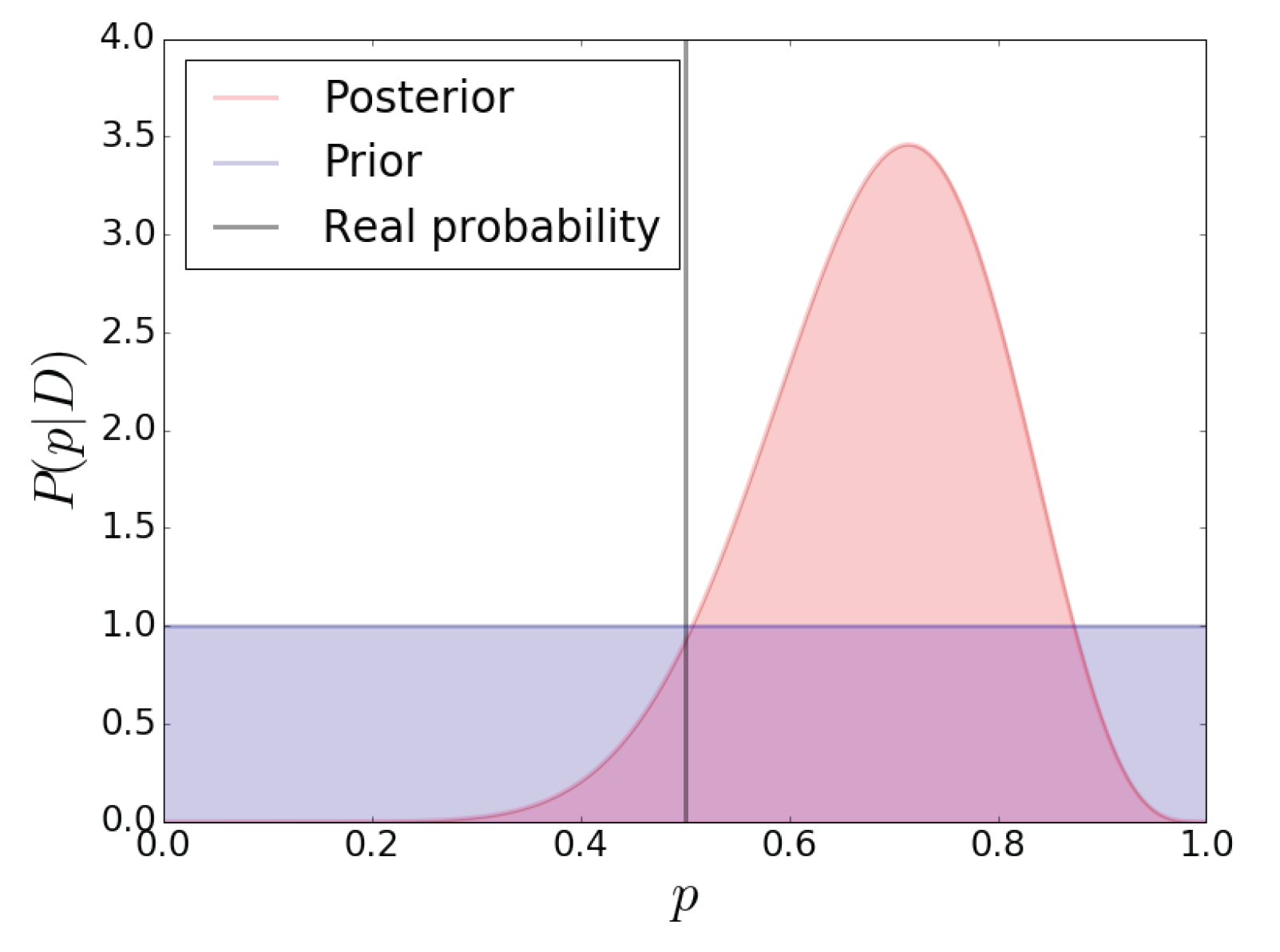



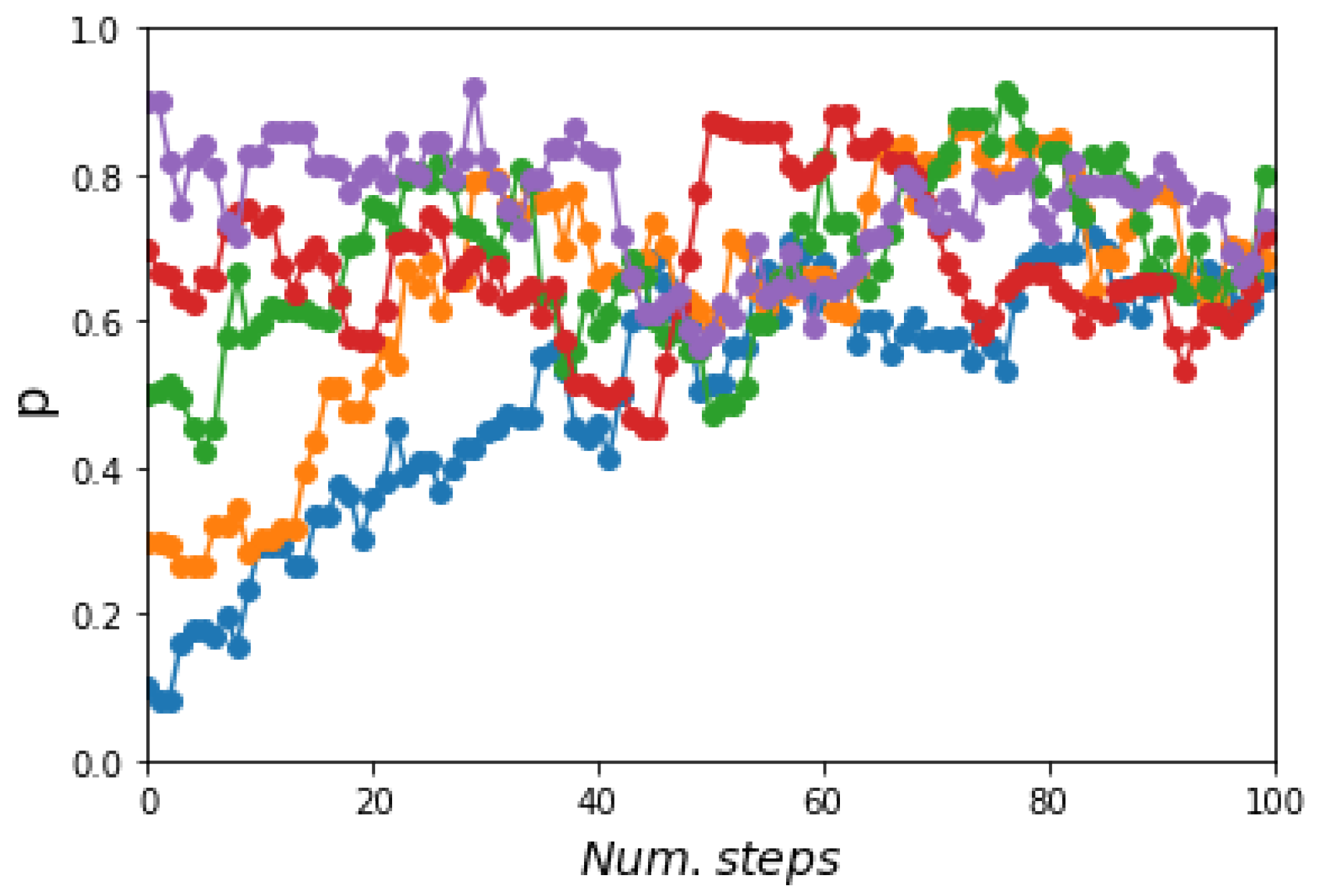
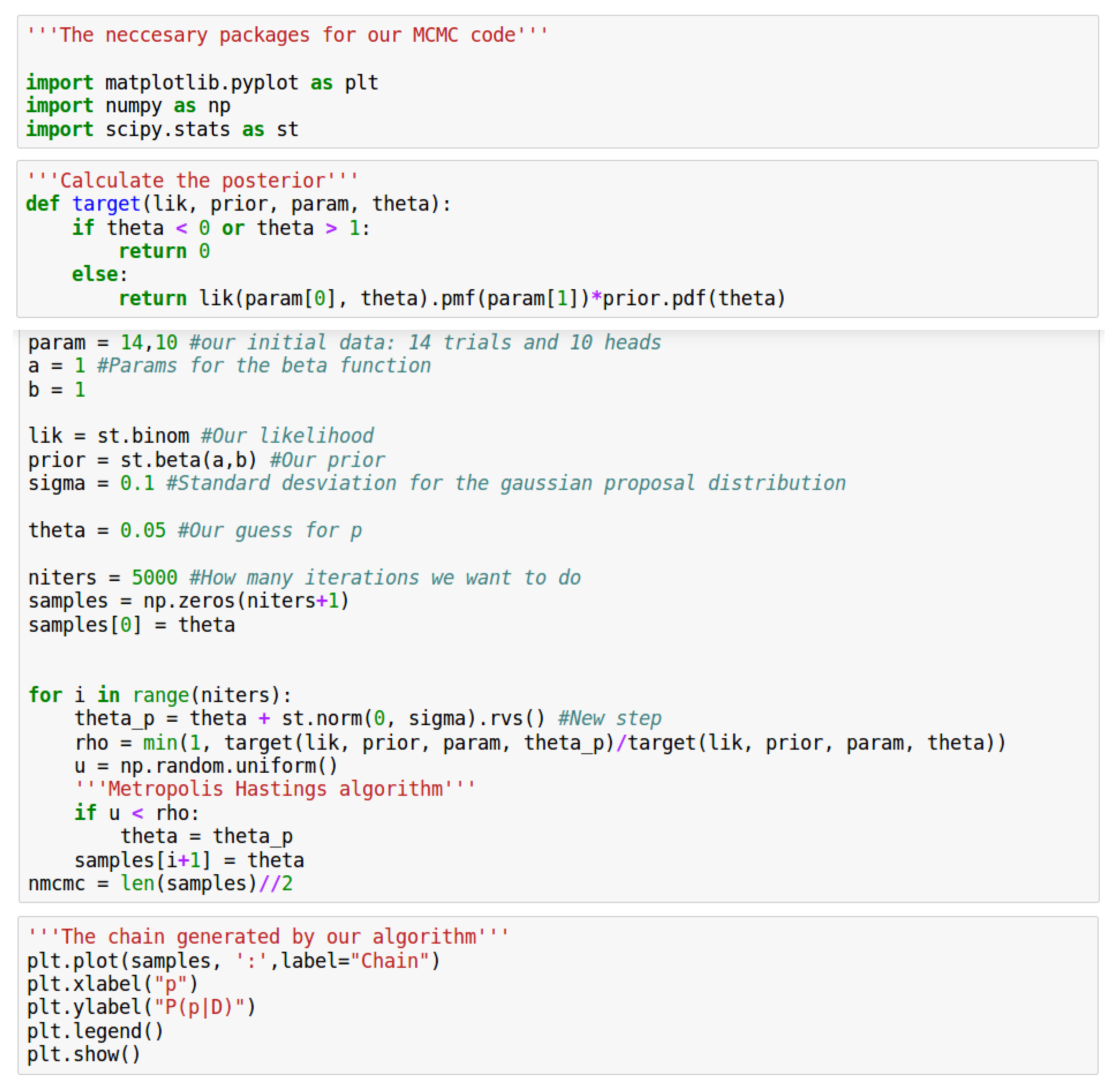

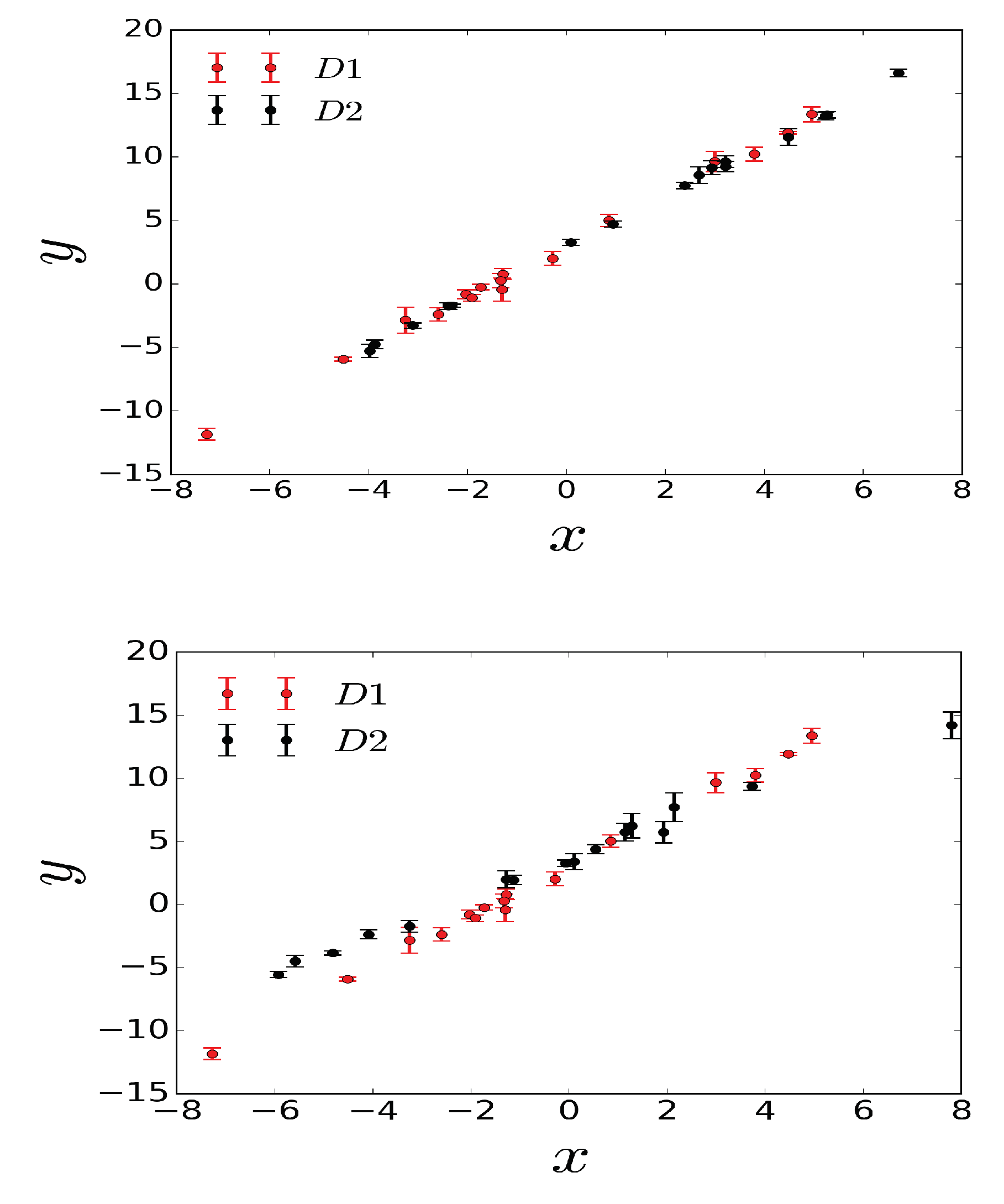





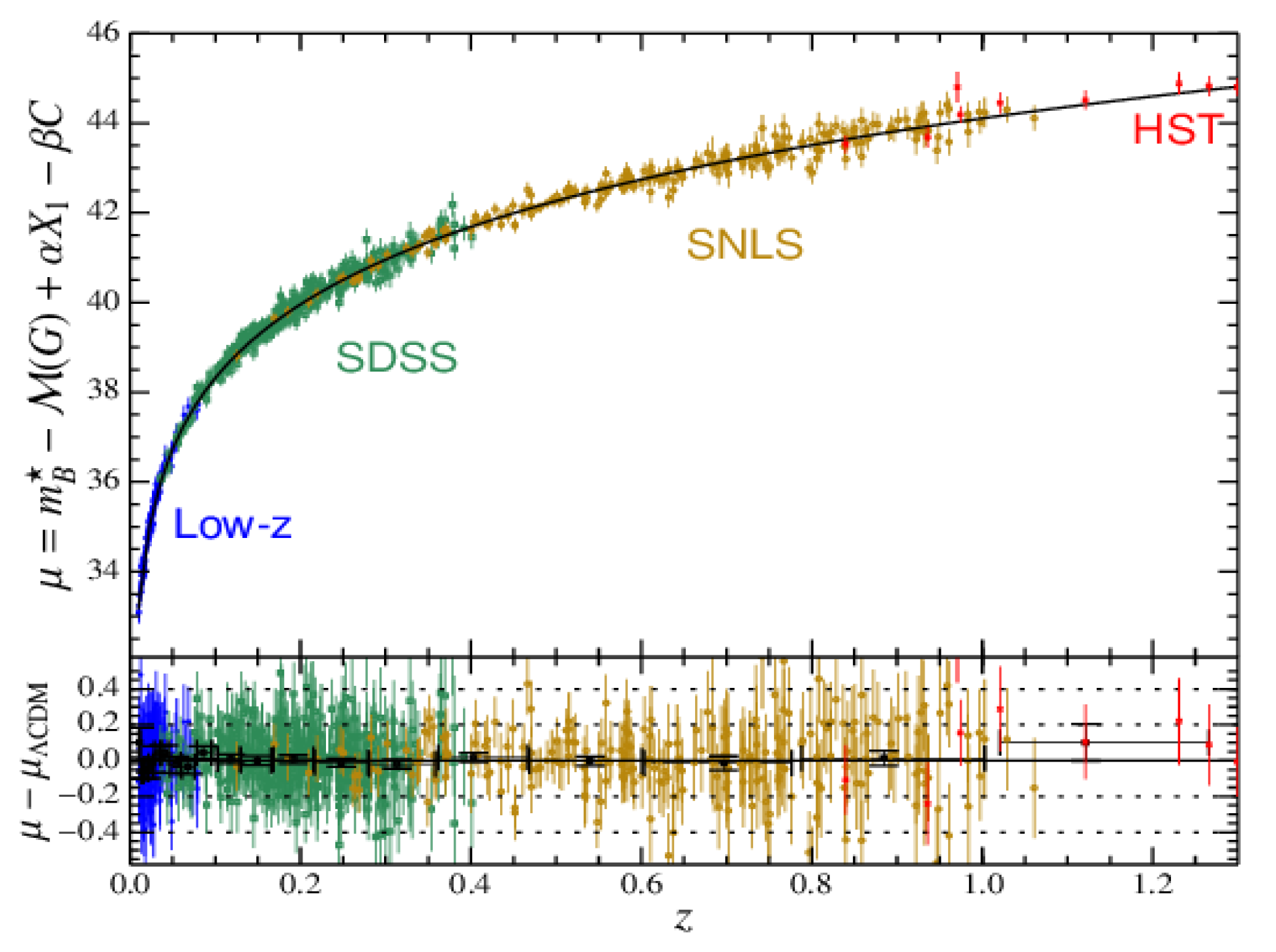



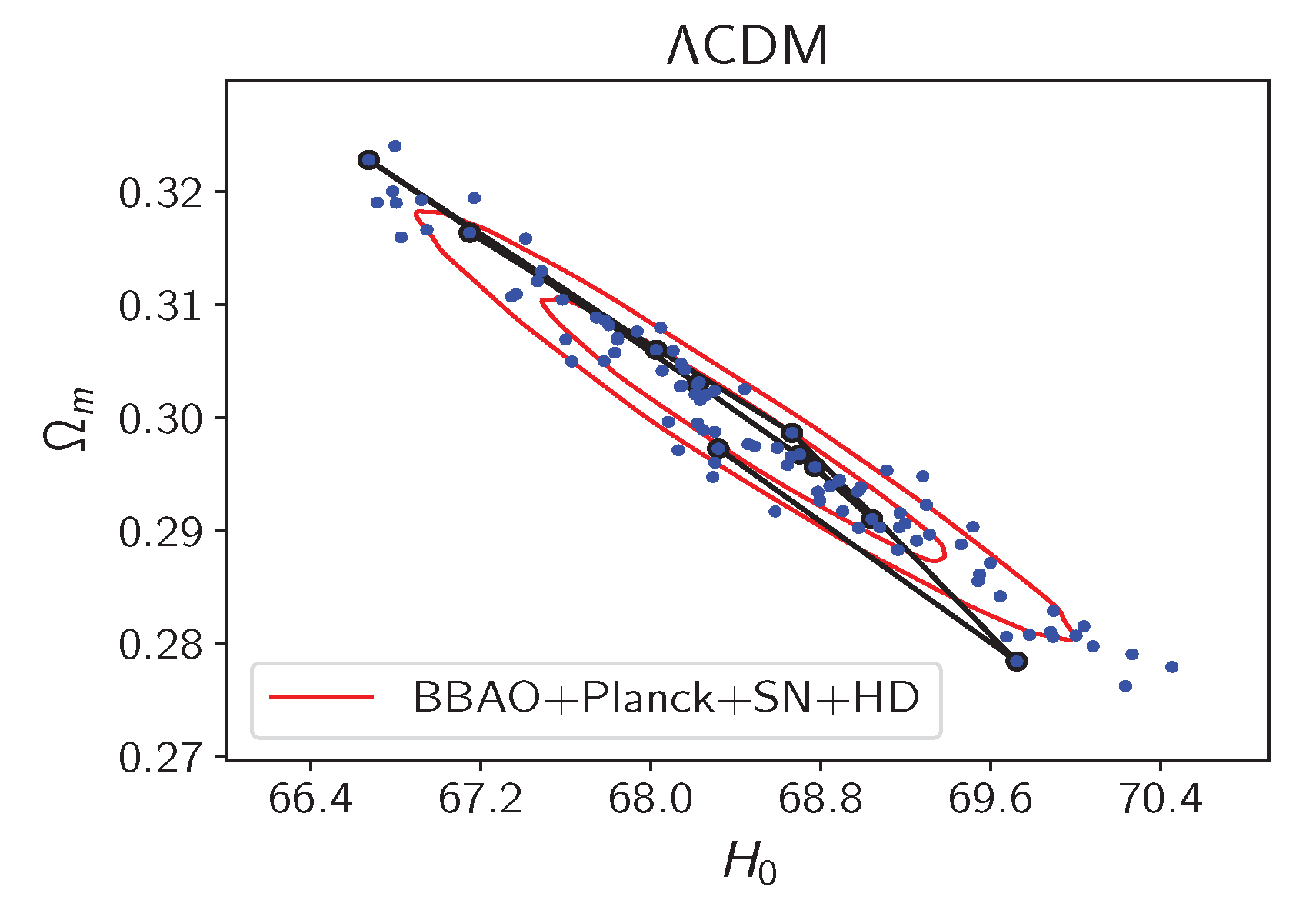

| Frequentist | Bayesian |
|---|---|
| Data are a repeatable random | Data are observed from |
| sample. There is a frequency. | the realized sample. |
| Underlying parameters remain | Parameters are unknown and |
| constant during this repeatable | described probabilistically. |
| process. | |
| Parameters are fixed. | Data are fixed. |
| Odds | Probability | Strength | |
|---|---|---|---|
| <1.0 | <3:1 | <0.750 | Inconclusive |
| 1.0–2.5 | ∼12:1 | 0.923 | Significant |
| 2.5–5.0 | ∼150:1 | 0.993 | Strong |
| >5.0 | >150:1 | >0.993 | Decisive |
| 1 | ||||
| 2 | ||||
| 3 |
| Component | |
|---|---|
| Dust | 0 |
| Radiation | 1/3 |
| Cosmological Constant | −1 |
| Parameter | CDM | oCDM | CDM | oCDM | CDM | oCDM |
|---|---|---|---|---|---|---|
| h | ||||||
| ⋯ | ⋯ | ⋯ | ||||
| ⋯ | ⋯ | |||||
| ⋯ | ⋯ | ⋯ | ⋯ | |||
| 0 | 3.61 | 1.48 | 5.59 | 1.23 | 4.3 |
Publisher’s Note: MDPI stays neutral with regard to jurisdictional claims in published maps and institutional affiliations. |
© 2021 by the authors. Licensee MDPI, Basel, Switzerland. This article is an open access article distributed under the terms and conditions of the Creative Commons Attribution (CC BY) license (https://creativecommons.org/licenses/by/4.0/).
Share and Cite
Padilla, L.E.; Tellez, L.O.; Escamilla, L.A.; Vazquez, J.A. Cosmological Parameter Inference with Bayesian Statistics. Universe 2021, 7, 213. https://doi.org/10.3390/universe7070213
Padilla LE, Tellez LO, Escamilla LA, Vazquez JA. Cosmological Parameter Inference with Bayesian Statistics. Universe. 2021; 7(7):213. https://doi.org/10.3390/universe7070213
Chicago/Turabian StylePadilla, Luis E., Luis O. Tellez, Luis A. Escamilla, and Jose Alberto Vazquez. 2021. "Cosmological Parameter Inference with Bayesian Statistics" Universe 7, no. 7: 213. https://doi.org/10.3390/universe7070213
APA StylePadilla, L. E., Tellez, L. O., Escamilla, L. A., & Vazquez, J. A. (2021). Cosmological Parameter Inference with Bayesian Statistics. Universe, 7(7), 213. https://doi.org/10.3390/universe7070213






